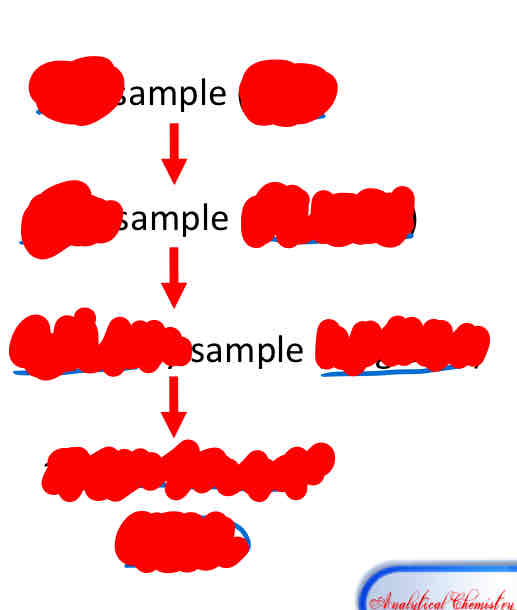sampling and sample preparation
1/62
There's no tags or description
Looks like no tags are added yet.
Name | Mastery | Learn | Test | Matching | Spaced |
|---|
No study sessions yet.
63 Terms
proper sampling
process of obtaining a portion of a material that will represent the subject under study
gross sample
consists of several portions of the material to be tested
laboratory sample
small portion of the sample that is actually analyzed
aliquot
measured portion of the volume of a liquid sample taken for the analysis

bulk, ton; gross, kg; laboratory, <1g; analytical sample; aliquot
representative sample
a sample that is typical of the parent material for the characteristic under inspection
static system
compositionoftheparentmaterialispermanentwith respect to position in space and stable in time
dynamic conditions
the parent material is changing with respect to time; removal of a portion at any instant represents only a snapshot of that moment in time and in that particular location
composite sample
consists of two or more portions of material (collected at the same time) selected so as to represent the material being investigated
in situ sample
allows monitoring the target population without removing individual grab samples
grab sample
a portion of the target population is collected at a specific time or location, providing a “snapshot” of the target population
grab sample
1/50th of the total bulk
grab sample
easiest but less reliable
grab sample
type of sample that is only satisfactory for homogenous sample
grab sample
best and easy time for sampling is during transportation
random sampling
any portion of the material has an equal and known chance of being chosen
random sampling
leas biased approach to sampling
selectove (judgemental) sampling
a sample which is deliberately chosen by using a sampling plan that screens out materials with certain characteristics and/or selects only material with other relevant characteristics (directed/focused sampling)
convenience sampling
a sampling plan in which samples are collected because they are easily obtained
systematic sampling
the sample is taken according to a previously arranged regular intervals in time or space.
Systematic–judgmental sampling
a prior knowledge about a system to guide a systematic sampling plan
Stratified (judgmental–random) sampling
population being sampled is divided into segments (or strata) and a simple random sample is selected from each
sampling, sample preservation, sample preparation, analysis
method for taking appropriate sample
siphoning, decanting, or by using a pipet or syringe
homogenous samples are easily sampled by?
grab
what type of sampling method is alright with sampling liquids?
serum
fluid separated from clotted blood
plasma
fluid separated from unclotted blood
plasma
fluid separated from clotted blood
naf, anticuagulant (heparin)
use preservatives such as ___ for glucose and ___
vacutainers
evacuated tubes with rubber cap for storing biological fluids
flow rate and depth
the chem comp of surface waters such as streams, rivers, lakes, and estuaries are influeced by?
grab samples
type of sample used in natural water
submerge the capped bottle below the surface, then remove cap. After the sample bottle is filled, cap is replaced then bottle removed.
how to collect natural water?
glass containers
natural waters - used for collecting samples for the analysis of pesticides, oil and grease, and organic
plastic bottles
natural water - used for collecting samplesfor the analysis of trace metals
control ph and temperature, limiting its exposure to light or to the atmosphere, or by adding a chemical preservative
how to preserve natural waters?
displacement of liquids (not reacting with or solubilizing the sample)
sampling method for gases
cryogenic cooling
changes the sample from gaseous to a liquid state (>150 K using He, H2, or N2).
in situ
type of smapling that the reaction between the gas and the reagent takes place ???
sampling with enrichment
gas is adsorbed onto a solid collection phase or adsorbed into a solution
sampling without enrichment
used for determining organic gases that occur permanently in the air or workplace
direct sampling: a gas storage vessels, gas-tight syringes, or gas sample bags pumped at 1-3 L/min flow rate
sampling of gases generally uses?
impingers (bubblers)
special glass tubes designed to collect airborne contaminants by bubbling the sample air at a high flow rate onto a specific absorbing liquid inside.
solid sorbent, filter, cryogenic cooling
sample preservation for gases
grab samplers
pair of jaws that close when they contact the sediment, scooping up sediment in th process.
tendency to lose finer particles
disadvantage of grab samplers
cylindrical coring device
maintains their vertical profile when collecting sediment samples
small surface area is sampled
disadvantage of cylindrical coring device
soil punch
thin-walled steel tube, may be used, which retains the core sample when it is pushed into the soil and removed
scooping, thieving, cone & quartering
3 static sampling for powder
table sampling, chute splitting, spin riffling
3 dynamic sampling for powder
scoop sampling
widely used and consists of plunging a scoop into a heaped batch
thieving
plunging a capture devise
cone & quartering
combination of crushing and grinding the gross sample
table sampling
powder flow along incline table
chute-splitting
v-shaped
spin riffling
uses mechanical energy
sawing, milling, or drilling
how to obtain metal alloys
sampling spears (sack samplers) (40-45 cm)
most commonly used for taking samples from bags. what sould be the length?
distilled water; methanol, chloroform, or toluene
sample dissolution used for inorganic salts uses ___, while ___ for organic materials
acid/base
With samples that are difficult to dissolve, the first approach is usually to try digesting the sample with ____
higher temperatures (200–300 °C) and pressures (40–100 bar) and consequently, may be accomplished in less than 30 min.
microwave digestion must be at?
large excess of alkali metal selt (flux)
• Inorganic samples that resist decomposition by digestion with acids or bases often can be brought into solution by fusing with a?